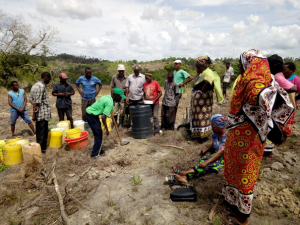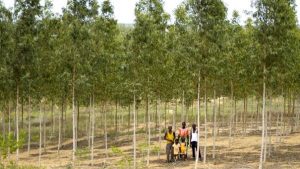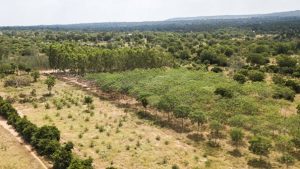Continuing a series of interviews on inclusive landscape finance, Tevis Howard, founding director of Komaza, shares his insights with Bas Louman of Tropenbos International.

Komaza, founded in 2006, is a vertically integrated forestry company that is involved in forest production from tree nurseries, tree cultivation, harvesting and processing, to selling to domestic and international customers. The company is based in Kifili, Kenya.
Different from other forestry companies in Africa, which produce timber in large plantations, its production is based on thousands of small woodlots in partnership with as many smallholder farmers.
This fits into the production model in Kenya well, where more than 50 percent of the wood supply comes from such farmers.
By aggregating the wood production of these small farmers, Komaza has been able to link them to the traditional wood value chain.
Tevis Howard gives us some insights into the challenges and opportunities he faced in seeking finance during the 13 years since the foundation of the company.
What does ‘inclusiveness’ mean to you?
Inclusiveness seems to be more of an academic issue and can mean many things, at all segments of the value chain, from production to consumption. What counts is that products are useful and accessible to everybody, whether they be financial products, material inputs for tree production or the final products of the wood value chain. Partnerships should be mutually beneficial and include people in transactions or agreements because it is valuable to do so, and not just because it is politically correct.
In our case, partnering with smallholders is a clear business strategy which allows us to reach scale while reducing risks and costs. At the same time, farmers have low risk, significantly increase their assets, and have an expectation of additional future income. Our experience is that partnerships as a whole have created greater benefits for all than could have otherwise been achieved.
Read also: Moving towards a more integrated view on finance and impact
What are the structural barriers to financing smallholders and small- and medium-sized enterprises (SMEs)?
I think you need to address this question at two different levels: first there is Komaza itself, which started up as an SME, although it has now grown to a full-sized company. Secondly, you need to look at the smallholders who grow the trees.
For Komaza there were four big challenges: the first three, to attract the right staff, choose the right farmers to work with and find the buyers, were straightforward challenges that most businesses have. Staff need to be motivated, farmers need to be willing to plant and maintain the plantations, and the customers need to be willing to buy at the offered quality-price relation.

Finding the finance to support operations, however, was another matter. The biggest challenge we had was to find investors that were prepared to take the risk to invest in our operations. This went beyond developing the right business models. It required investors to be familiar with the region and interested in investing in early stages of the business. Then we had to convince them that it was worth investing in this asset class, that we were able to manage the risks, and that our model had reduced costs in comparison to traditional tree plantation models.
At the level of the smallholders, the main barriers to becoming involved in tree planting relate to adequate knowledge on tree planting as a business, the costs and availability of inputs for tree plantations, and the requirements for obtaining loans.
How have you addressed these barriers, and what have you learnt from this?
Initially, we aimed at obtaining grant money from social enterprises seeking impact. Using this to build up our model, we were able to obtain convertible loans and equity investments, blending development with commercial money. Financiers invested in Komaza, helping it to grow its assets in trees and a range of different SME processing facilities.

After 11 years of building the enterprise, we now have a company with thousands of partners, together worth more than 20 million USD and with expertise across the forest value chain. Much of the work was through personal contacts, establishing trust between Komaza and the potential financiers and between Komaza and partners throughout the forest value chain. In addition, we developed a people-centered company, which helps motivate both farmers and staff to work together in a cost-effective manner while at the same time operating within a corporate structure that is credible to investors.
With respect to the barriers of the farmers, we have been able to come to agreements where they provide land and labor, and we provide technical assistance – the required inputs for tree farming. This helps us to keep costs down (in conventional plantations labor costs may be more than half of total costs) while they invest in the plantation without getting into debt, converting their labor into assets (trees). Once trees have reached the appropriate size, we harvest, transport and sell the trees, sharing the benefits of the sales with the farmers.
Subsistence farmers may find it difficult to obtain documentation that they own their land or other assets, which they would need, for example, to obtain commercial loans. In order to become a partner of our company, we require that their ownership is recognized by neighbors, chiefs and community leaders. This has the added advantage of lowering the risk of land right conflicts.
Finally, we make sure that the area planted with trees is in addition to the area needed for subsistence farming, to ensure that their food provision is not endangered by the wood production. In some cases, farmers also produce food in between the trees during the first years of the plantation.
Read also: Financial products should be adjusted to better meet needs of community forest enterprises
What suggestions do you have to scale up this type of inclusive business model?
We have been able to scale up due to a number of factors: a realistic corporate structure; a human-centered approach, where we discuss with farmers their problems and how our partnership could address some of these; building motivated expertise across the forest value chain; and building relations of trust with farmers, staff, processors, buyers and financiers. This has taken more than 10 years. We have now come to a stage where, with the help of grants, and later blended finance, we have shown the business case and have attracted commercial equity and debt investments in our firm.

Only the private sector can invest sufficient amounts in order to reach the scale necessary to create a wood supply from sustainable sources that is able to meet demand. For that reason, we are in the process of creating our Smallholder Forestry Vehicle. Through this vehicle we hope to contribute to filling the gap between financiers that want to invest in sustainable projects but cannot find viable proposals, and the farmers that want to change to more sustainable forms of production but cannot find the finance.
For replication of this type of investment in other areas, we suggest that rather than starting from scratch, it will be important to seek partners that already have the experience, have a network of trustworthy relations, and are motivated to work with trees in the area.
One of the major issues in the forestry sector in Africa is unsustainable production. Scaling up sustainable wood production may not be feasible if at the same time national governments do not take measures to reduce wood from unsustainable sources. One way of doing this would be to raise taxes on wood from unsustainable sources.
By Bas Louman, Tropenbos International.
This interview has also been published on the Tropenbos International website.
This article was produced by Tropenbos International (TBI) and the Center for International Forestry Research (CIFOR) as part of the CGIAR Research Program on Forests, Trees and Agroforestry (FTA). FTA is the world’s largest research for development program to enhance the role of forests, trees and agroforestry in sustainable development and food security and to address climate change. CIFOR leads FTA in partnership with Bioversity International, CATIE, CIRAD, INBAR, ICRAF and TBI. FTA’s work is supported by the CGIAR Trust Fund.











